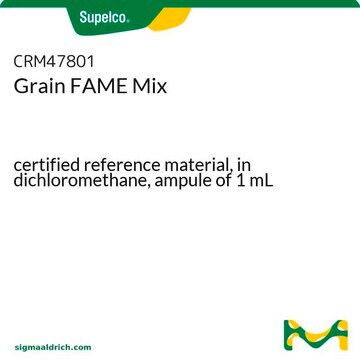47080-U
Mélange d′esters méthyliques d′acides gras bactériens (BAME)
solution (10 mg/mL total concentration in methyl caproate), analytical standard
About This Item
Produits recommandés
Qualité
analytical standard
Niveau de qualité
Forme
solution (10 mg/mL total concentration in methyl caproate)
CofA (certificat d'analyse)
current certificate can be downloaded
Conditionnement
ampule of 1 mL
Technique(s)
HPLC: suitable
gas chromatography (GC): suitable
Application(s)
food and beverages
Format
multi-component solution
Température de stockage
-10 to -25°C
Description générale
Check out our complete portfolio of Fatty acid methyl ester (FAME) reference material solution mixes
Application
- Development of a method to identify bacteria based on the gas chromatographic-vacuum ultraviolet spectroscopic (GC-VUV) analysis of bacterial fatty acid methyl esters (FAMEs)
- Fatty acid methyl ester (FAME) profiling of biodiesel obtained from microbial oil after its transesterification by gas chromatography-mass spectrometry (GC-MS)
- GC-FID method-based separation and determination of fatty acid methyl esters (FAMEs) in the lipid extracts of leptocephalus larva of eels
Autres remarques
Analyte
Application
Produit(s) apparenté(s)
Mention d'avertissement
Warning
Mentions de danger
Conseils de prudence
Classification des risques
Flam. Liq. 3
Code de la classe de stockage
3 - Flammable liquids
Classe de danger pour l'eau (WGK)
WGK 3
Point d'éclair (°F)
109.4 °F - closed cup
Point d'éclair (°C)
43 °C - closed cup
Équipement de protection individuelle
Eyeshields, Faceshields, Gloves, type ABEK (EN14387) respirator filter
Faites votre choix parmi les versions les plus récentes :
Déjà en possession de ce produit ?
Retrouvez la documentation relative aux produits que vous avez récemment achetés dans la Bibliothèque de documents.
Les clients ont également consulté
Protocoles
Separation of null
Protocol for GC Analysis of Bacterial Acid Methyl Esters (BAMEs) on Equity®-1
Chromatograms
suitable for GCsuitable for GCGlobal Trade Item Number
| Référence | GTIN |
|---|---|
| 47080-U | 4061832359403 |
Notre équipe de scientifiques dispose d'une expérience dans tous les secteurs de la recherche, notamment en sciences de la vie, science des matériaux, synthèse chimique, chromatographie, analyse et dans de nombreux autres domaines..
Contacter notre Service technique










